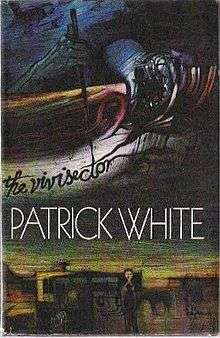The Vivisector
 First edition cover | |
| Author | Patrick White |
|---|---|
| Cover artist | Tom Adams |
| Country | Australia |
| Language | English |
| Publisher | Jonathan Cape |
Publication date | 1970 |
| Media type | |
| ISBN | 0-14-003693-8 |
| OCLC | 29002043 |
| 823 | |
| LC Class | PZ3.W58469 Vi5 PR9619.3.W5 |
The Vivisector is the eighth published novel by Patrick White. First published in 1970, it details the lifelong creative journey of fictional artist/painter Hurtle Duffield. Named for its sometimes cruel analysis of Duffield and the major figures in his life, the book explores universal themes like the suffering of the artist, the need for truth and the meaning of existence.
Background
The longest of White's novels,[1] The Vivisector was written in 1968. While the novel was dedicated to painter Sidney Nolan, White denied any connection between Hurtle Duffield, the novel's central character, and Nolan or any other painter.[2] Other literary critics have interpreted the novel as being largely autobiographical,[3] with Australian literary critic Geordie Williamson noting that "The Vivisector is a great Australian novel. I think it is one of White's, I think it's White's great autobiography to be honest."[4]
Plot summary
Hurtle Duffield is born into a poor Australian family. They adopt him out to the wealthy Courtneys, who are seeking a companion for their hunchbacked daughter Rhoda. The precocious Hurtle gains artistic inspiration from the world that surrounds him, his adoptive mother, Maman, and Rhoda; the prostitute Nance, who is his first real love; the wealthy heiress Olivia Davenport; his Greek mistress Hero Pavloussi and finally the child prodigy Kathy Volkov. He becomes famous and his paintings are in great demand. However, he is unimpressed by the monetary and status gain this brings and continues to live a spartan life, beholden to nobody — even the Prime Minister. In his final years he is drawn closer to his sister Rhoda, and after a stroke causes partial paralysis, is assisted by his protégé Don Lethbridge to produce a huge, final magnum opus to God — the Vivisector.
Awards
White's biographer, David Marr, has claimed that White was being considered by a Nobel Prize committee to receive the Nobel Literature prize. However, the committee was reportedly offended by one of the central themes of the novel, which posed the question as to whether it was possible to be a human being and an artist at the same time, and decided not to award the prize to White that year.[5] He later won the Literature prize in 1973.[6]
White was announced, on 26 March 2010, as one of six authors shortlisted for the "Lost Man Booker Prize" of 1970, a contest delayed by 40 years because a reshuffling of the fledgling competition's rules that year disqualified nearly a year's worth of high-quality fiction from consideration.[7][8][9]
See also
References
- ↑ "Why bother with Patrick White?". ABC Online. Australian Broadcasting Corporation. Retrieved 22 May 2010.
- ↑ "Voss and The Vivisector – Patrick White – Book Clubs – Penguin Group (USA)". Penguin Books. Retrieved 22 May 2010.
- ↑ Birns, Nicholas; McNeer, Rebecca (2007). A companion to Australian literature since 1900. Camden House. p. 249. ISBN 978-1-57113-349-6.
- ↑ "The World Today – Lost Man Booker prize named 20/05/2010". ABC Online. Australian Broadcasting Corporation. Retrieved 22 May 2010.
- ↑ Marr, David. Patrick White: a life. p. 534. ISBN 978-0-09-999850-1.
- ↑ "Literature 1973". Nobel Prize. The Nobel Foundation. Retrieved 22 May 2010.
- ↑ Hoyle, Ben (26 March 2010). "Author waits to hear if she has won lost Booker prize 40 years on". The Times. London.
- ↑ "Australian authors shortlisted for lost Man Booker Prize". The Sydney Morning Herald. 26 March 2010. Retrieved 7 April 2010.
- ↑ Sorensen, Rosemary (27 March 2010). "Patrick White on 'Lost Booker' shortlist". The Australian. Retrieved 7 April 2010.